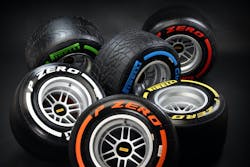Just one week after the Chinese Grand Prix, Formula One moves to Bahrain where the P Zero Orange hard and P Zero White medium tyres have been nominated.
At the Bahrain International Circuit, high track and air temperatures are expected, along with a track surface that is frequently made dirty by sand from the surrounding desert. Bahrain is a fast, flowing and technically demanding circuit, which made it the perfect test venue for Pirelli when the Italian firm was preparing for its Formula One return. Traction and braking are the main demands of the 5.412-kilometer variable width track, with tyre degradation expected to be reasonably high – which is why the two hardest compounds of the range have been nominated.
Paul Hembery: “Bahrain was one of the very few circuits that was entirely new to us in competition last year, although we know it well from testing. It’s one of the most demanding tracks of the year for the tyres, mostly because of the high ambient and track temperatures. We expect about three stops per car, although we’ll have to wait to get some running in on Friday before we can look at the data and make a more accurate prediction. One of the main challenges of racing in Bahrain is that the track evolution is very hard to predict, depending on how much sand is blown onto the circuit. From what we saw last year though, there will be plenty of scope for different race strategies, which can even allow drivers who have not qualified as well as they hoped to recover during the grand prix.”
Jean Alesi: “Bahrain is a circuit that I never raced on during my Formula One career, but I did race there in the Speedcar series – similar to NASCAR – in 2009: in fact I won the race. After a change to the layout the track has now gone back to its original version and it’s a nice circuit that you definitely have to find a rhythm with. If you do this, it will bring you a good lap time but it will also make sure that your tyres stay in the best possible condition, which will be an important part of the race. It’s a circuit that is quite demanding on tyres, but this is an area where the driver always has an influence. Bahrain is also a physically demanding track, so a good level of physical preparation is necessary.”
The tyre from a circuit point of view:
• Bahrain is one of the most demanding tracks of the year in terms of longitudinal energy going into the tyres: especially under braking in turns one and 14, and traction in turn 10.
• Braking is in fact a key characteristic of the Bahrain International Circuit: in the first corner the cars decelerate from 315kph to 65kph in just 130 meters and three seconds. This places a force on the tyres equivalent to around 4.5g.
• Lateral energy is about average for the year, reaching a peak in turn 12.
• Last year, the medium and soft tyres were selected – but this year’s compounds are all much softer than their equivalents last year, meaning that the 2013 hard tyre is more similar to the 2012 medium. The top five finishers selected a three-stop strategy at last year’s Bahrain Grand Prix, all starting on the soft tyre. However, the way they used the soft and the medium was quite different. The top-placed two-stopper came sixth.
Latest in Retail
Latest in Retail



